Let me warn you before you read any further that there are some pretty graphic and downright sickening images in this update. I don’t normally include this sort of thing, but this needs to be publicized, so please feel free to forward this everyone you know, including the village idiot and/or jerk (and you KNOW you’re acquainted with someone who fits the bill; all of us are).
It’s been a hellish couple of weeks, with three intakes, all three euthanasias, and all three suspected criminal activity. Yep, in two weeks, I’ve had to contact the feds three times–that’s already more than I had to contact them for all of 2008 combined, and this is just mid-February.
On Feb. 2, I was alerted to a downed hawk located about halfway between me and raptor rehabber Steve Hicks. Because my schedule was more flexible, Steve asked me if I’d pick up the bird, which people had become concerned about after seeing it sit near their pool all day. When I got the bird, a red shouldered hawk, and examined his right wing, I knew it was broken and suspected it was a result of a gunshot. I admit to being a little quick to assume gunshot on occasion, but this one looked and felt like it had been shot. X-rays were needed to confirm.
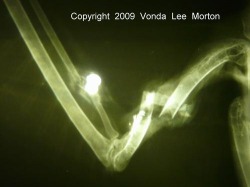
When I got the hawk back to Dublin and to Smalley’s, sure enough, X-rays confirmed that the bird had been shot. You can see on the X-ray the flecks of lead remaining in one area of the break, and the pellet is lodged in the other. Making it worse, we had no way of knowing where or when it might have happened, as the bird had been down a while and was rail-thin. The exposed ends of the bone on the larger fracture had also begun to die, so even though the breaks were both mid-bone–normally a good thing–there was no chance these would heal.
FWS (the feds) were alerted to this one, after much swearing by me and veterinarian Jim Hobby at what we suspected was some unsupervised child with a pellet gun, whose parents had never taught him that if you can’t eat it, you don’t shoot it.
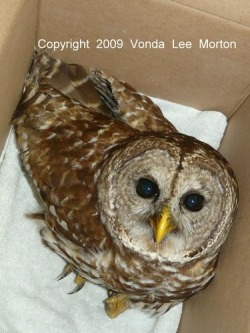
Then, on Feb. 8, I got a call about an owl with a broken leg. Upon picking him up, I discovered that in fact, both legs were broken: the left leg was an open fracture and the right leg was a closed fracture, both in the same general location on the bone. This bird had also been down a while and was rail-thin. I called Steve Hicks and described what I was seeing, sending him a photo of the open fracture and explaining that the owl–a first-year barred owl–was also very calm and readily ate chunks of raw meat from forceps, which is very unusual for barred owls, even when they’re starving. Based on the photo and the description of his behavior, Steve guessed that the bird had been captured or stolen from the nest while young and hand-raised, and that the fractures were a combination of improper handling and diet.
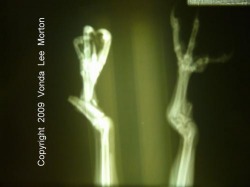
Since he came in on a Sunday, I had to wait until Monday morning to get him to the vet, where there was nothing to do but euthanize, but Peggy Hobby did X-ray the legs afterwards so that we could get a better look at the extent of the damage. Her assessment was the same as Steve’s: improper handling in captivity. FWS got called on this one, as well.
And Feb. 13, I got a call about yet another hawk, this one with a broken leg. The caller had been enjoying watching this bird and his mate for some time and was very upset that he was downed, with his mate flying overhead, screaming. When I picked up this bird, a broad winged hawk, I was shocked to see that the flesh had literally been peeled back from his left leg, exposing the bone and tendons beneath. Additionally, his leg was broken at the joint and one of his toes faced the wrong way. I couldn’t figure out what might have happened: this was a fresh wound; it was still bleeding.
Jim Hobby and I discussed possible scenarios as we examined the bird, who had no other wounds, not even a feather out of place. Predators didn’t seem likely; there would have been more extensive wounds. We debated a trap of some kind, but neither of us was sure: wouldn’t the break have been mid-bone, rather than in the joint? Wouldn’t the trap have just snapped the leg off, for that matter? It was an academic question, anyway, as the leg was beyond trashed and the hawk would have to be euthanized.
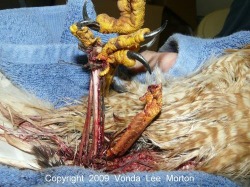
I sent Steve a photo of the hawk’s leg, and he confirmed that what we had seen was indeed the result of the hawk’s having been caught in an older steel-jawed trap, with weakened tension: he’d seen this kind of injury before. FWS was once again contacted.
I realize the details here are somewhat vague, but since these are cases the feds are investigating, I don’t want to screw up their work. In fact, I’d really like for them to allow ME to mete out some Hammurabian justice if they ever catch the culprits in any of these cases. I’m a firm believer in the punishment fitting the crime, and I have some very fitting punishments in mind for the cretins who fatally injured these three gorgeous birds.
Folks, feel free to print this out and use it to educate people and to remind them that injuring or killing birds–raptors and songbirds alike–is a federal offense. In fact, remind everyone you know that even disturbing an active nest (eggs in the nest; female on the nest; babies in the nest) is a violation of federal law, as is attempting to keep/raise birds without a federal permit. And don’t hesitate to report anyone you know is or suspect of engaging in any of these activities, especially if they’re stupid enough to brag about it. In Georgia, call the FWS Law Enforcement Office at 404-679-7057; outside Georgia, visit www.fws.gov/le and click on "Regional Offices" to locate the FWS LE office nearest you. Your action could save the life of a federally protected species.
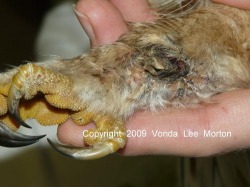
 RSS Feed
RSS Feed
